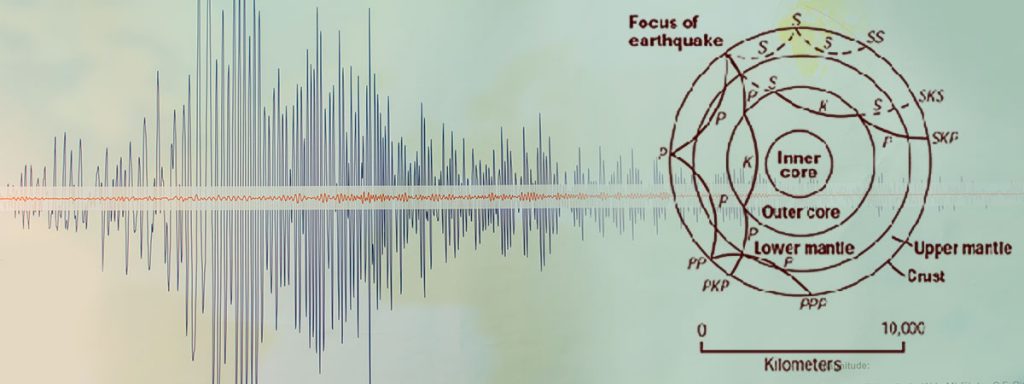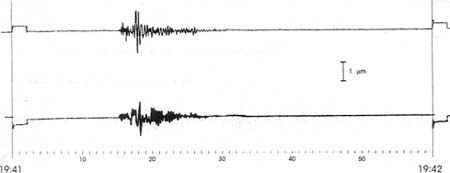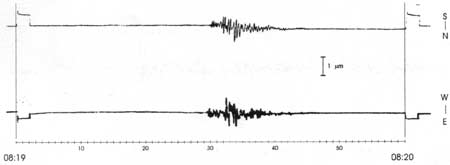
Seismic traces
what is happening with our earth?
- Rothert und J. Ritter, Göttingen
in: Bulletin of the German Geophysical Society (DGG), 1/1999, p. 9-14
(Note: This section of the original article contains numerous images of seismograms, of which only the recordings of the 17-t pendulum are shown here due to lack of space.)
The seismic recording of the explosion of 30/12/1998 was discovered by the technical supervisor of the Wiechert seismograph of the Institute of Geophysics, Mr Wilfried Steinhoff, during routine maintenance. The image shows the horizontal traces of the 17-t pendulum as magnified contact prints of the smoked-paper recordings. The arrival of the P wave and the subsequent surface waves are clearly recognisable. A shear wave, which was to arrive 0.6 s after the P wave, cannot be identified. The recordings at the station of the German Regional Seismic Network (GRSN) in Clausthal also show hardly any S wave arrivals (image not shown here). The original Z, N-S and E-W components were rotated in ray direction according to Plesinger et al. (1986). The frequency-dependent ground movement measured by the Wiechert seismograph in Göttingen is about 0.26 µm for the P wave and 0.78 tm for the surface wave. To calculate the ground movement, the transfer function according to Geiger (1909) and the current calibration values ascertained by Dr. Schreiber (Göttingen) were used. The distance to the explosion site is about 3.3 km. The travel time of the P wave can be estimated at about 1 s (extrapolated according to Müller, 1934). Based on this, the detonation was initially determined to have occurred at 08:19:28 a.m. GMT ± 0.5 s. The time synchronisation of the seismic recording is done using the DCF time signal. Eyewitnesses previously stated the detonation time to be between 08.20 and 08.23 a.m.
Taking the observations in Clausthal into account, the inaccuracy in determining the origin time has to be indicated somewhat greater (about ± 1 s), because different travel times to Clausthal are calculated for the events of 1992 and 1998: about 7 s for 1992 and roughly 9 s for 1998. This is likely to be attributable to inaccuracies in time synchronisation at the historical station in Göttingen. The observed travel times to Clausthal yield apparent velocities of 6.4 and 5.2 km/s for the P wave. The mean value of 5.8 km/s corresponds to the velocity of the P wave in the upper crust, as was measured in this area during the European Geotraverse (Aichroth et al., 1992).
A comparison of the 1992 and 1998 seismic data was aimed at obtaining further information about the detonation. Apart from Göttingen’s smoked-paper recordings, the seismic impacts can also be seen in the data provided by the station of the German Regional Seismic Network in Clausthal located at a distance of 46 km. While the P wave trains are very similar, slightly higher surface wave amplitudes are observed for the 1992 bomb explosion. However, these differences are within the limits of observational uncertainty. Other seismic recordings of the events are not known.
The duration magnitude MD according to Willmore and Karnik (1970) was used to compare the magnitudes of the 1992 and 1998 events. The Göttinger station measures 1.0 ± 0.1 and the Clausthal station 1.4 ± 0.1 for both events. The conventional Richter magnitude scale ML delivers values of 0.5 – 0.7 for both explosions, with the results being relatively unreliable due to the weak signals and the limited data as well as the unknown amplitude decay function. Another comparison of the seismic energy of both events is delivered by squared amplitude spectra of the true ground vibration velocity in Clausthal. The resulting spectra after correction of the transfer function of the STS-2 seismometer and rotation into ray coordinates are shown in Fig. 4 (not shown here). A direct comparison between 1992 and 1998 also does not reveal any significant differences here. From the results of the magnitude and spectrum determination, it is inferred that the seismic waves generated were about equal in amplitude in both events.




